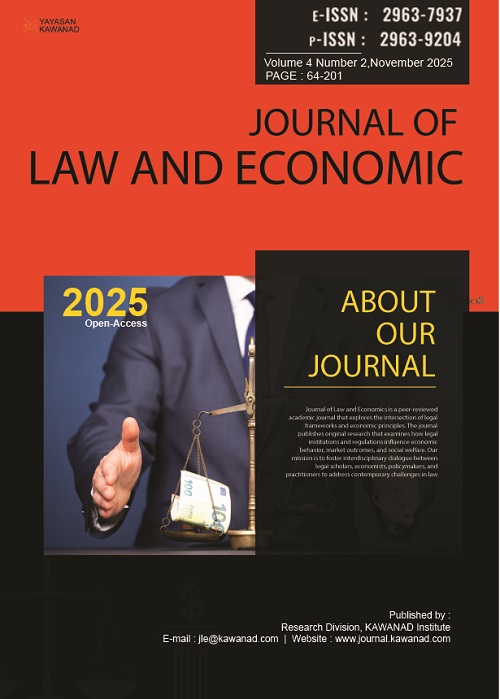TEMPLATE
- masriali@unsyiah.ac.id
- Banda Aceh City, Indonesia
- +6281360650791
Articles
- Home
- Archives
- Vol. 4 No. 2 (2025): NOVEMBER
- Articles
- Home
- Archives
- Vol. 4 No. 2 (2025): NOVEMBER
- Articles
Analysis of the Impact of 12% VAT Implementation on the Indonesian Economy: An Empirical Study of the U-Shaped Impact Phenomenon on Public Purchasing Power in the January-June 2025 Period
- Authors Wenti Frisca Septiani Putri , Oliviane Oroh , Dikdik Maulana
- Affiliations
- Published 2025-11-30
- Section Articles
- DOI https://doi.org/10.56347/jle.v4i2.342
- Issue Vol. 4 No. 2 (2025): NOVEMBER
0
Views
0
Downloads
Altmetrics
Abstract
This study examines the economic impacts of Indonesia's 12% Value Added Tax (VAT) during January-June 2025 using a Difference-in-Differences (DiD) approach. The VAT increase from 11% to 12%, effective January 1, 2025, aims to boost state revenue and support post-pandemic economic recovery. Analysis draws on time series data from Statistics Indonesia (BPS), Bank Indonesia, and the Ministry of Finance, along with household surveys and MSME data. Results show that the 12% VAT added 0.45 percentage points to national inflation, with manufacturing bearing the largest burden at 0.18 percentage points. A striking U-shaped pattern emerged in purchasing power effects: middle-income groups (quintile 3) suffered the steepest decline of 3.4%, while low and high-income groups experienced smaller reductions. The VAT exhibits regressive characteristics, pushing the Gini coefficient from 0.381 to 0.394 and raising poverty rates from 9.54% to 9.78%—forcing approximately 640,000 people below the poverty line. While state revenue increased by 18.7%, mitigation interventions worth 0.3-0.5% of GDP became necessary. The study recommends targeted mitigation strategies: focused social compensation, revised VAT-exempt goods lists, and integrated progressive tax reforms.
References
- Agustina, N., & Hartono, D. (2022). Dampak perubahan tarif pajak penghasilan badan dan pajak pertambahan nilai di Indonesia. Ekuitas (Jurnal Ekonomi dan Keuangan), 6(4), 456-475. https://doi.org/10.24034/j25485024.y2022.v6.i4.5359
- Alfiyah, N., & Latifah, S. (2017). Pengaruh pelaksanaan kebijakan sunset policy, tax amnesty, dan sanksi pajak terhadap kepatuhan wajib pajak orang pribadi. Jurnal Reviu Akuntansi dan Keuangan, 7(2), 1081-1090. https://doi.org/10.22219/jrak.v7i2.21
- Annisaa, M., & Nuryanah, S. (2023). Evaluasi manajemen perpajakan atas pajak pertambahan nilai (studi kasus pada perusahaan start-up X). Journal of Economics and Business UBS, 12(4), 2532-2549. https://doi.org/10.52644/joeb.v12i4.408
- Djufri, D. (2022). Dampak pengenaan PPN 11% terhadap pelaku dunia usaha sesuai UU No. 7 Tahun 2021 tentang harmonisasi peraturan perpajakan di Indonesia. Journal of Social Research, 1(5), 391-404. https://doi.org/10.55324/josr.v1i5.106
- Fadhiilah, A., & Rachmawati, N. (2024). Apakah promosi penjualan melalui media sosial dan potongan harga memengaruhi niat beli konsumen dengan kenaikan tarif pajak penambahan nilai sebagai variabel moderasi? Jurnal Akuntansi dan Keuangan, 13(1), 90-106. https://doi.org/10.36080/jak.v13i1.2818
- Fitriani, A., Putri, C. F., Fionasari, D., Harahap, P. D. S., & Hasibuan, S. A. (2025). Analisis dampak kenaikan tarif pajak pertambahan nilai (PPN) 11% terhadap PT Sari Kencana. Jurnal Akuntansi Audit dan Perpajakan Indonesia (JAAPI), 6(1), 709-715. https://doi.org/10.32696/jaapi.v6i1.4181
- Gunawan, F., & Sofiani, V. (2023). Pengaruh kenaikan tarif pajak pertambahan nilai (PPN) dan biaya bahan baku terhadap omset penjualan pada PT Buana Raya Lestari. Journal of Economics and Business UBS, 12(5), 2706-2721. https://doi.org/10.52644/joeb.v12i5.469
- Gultom, Y., Hidayati, R., Pratama, K., & Wijaya, S. (2022). Alternatif pengenaan pajak pertambahan nilai atas beras. Jurnalku, 2(4), 552-562. https://doi.org/10.54957/jurnalku.v2i4.336
- Hajatina, H., & Hasanah, U. (2024). Analisis dampak kenaikan tarif pajak pertambahan nilai (PPN) terhadap perilaku konsumsi dan kesejahteraan masyarakat di Indonesia. Jurnal Manajemen dan Bisnis, 3(2), 36-51. https://doi.org/10.36490/jmdb.v3i2.1452
- Konsultan ISO. (2025, January 15). Dampak penerapan PPN 12% bagi perekonomian. https://konsultaniso.web.id/ilmu-manajemen-bisnis/dampak-penerapan-ppn-12-bagi-perekonomian/
- Kurnaini, A. F., & Rahmawati, I. D. (2024). Analisis dampak kenaikan tarif pajak pertambahan nilai (PPN) terhadap daya beli masyarakat di Kabupaten Sidoarjo. Masip: Jurnal Manajemen Administrasi Bisnis dan Publik Terapan, 2(3), 45-56. https://doi.org/10.59061/masip.v2i3.737
- Liyana, N. (2021). Menelaah rencana kenaikan tarif PPN berdasarkan bukti empiris serta dampaknya secara makro ekonomi. Jurnal Pajak Indonesia (Indonesian Tax Review), 5(2), 124-135. https://doi.org/10.31092/jpi.v5i2.1394
- Novianto, R., Ramadhan, R., Azzahra, S., & Irawan, F. (2023). Menelaah kenaikan tarif pajak pertambahan nilai ditinjau dari asas keadilan. Jurnalku, 3(2), 187-195. https://doi.org/10.54957/jurnalku.v3i2.454
- Portal Informasi Indonesia. (2025, January 10). Strategi dongkrak penerimaan, jaga ekonomi tetap stabil. Indonesia.go.id. https://indonesia.go.id/kategori/editorial/8862/strategi-dongkrak-penerimaan-jaga-ekonomi-tetap-stabil?lang=1
- Pradana, R. (2022). Problematika pemulihan ekonomi nasional pasca pandemi dengan pemberlakuan kenaikan tarif PPN. Jurnal Asosiasi Pengajar Hukum Tata Negara Hukum Administrasi Negara (JAPHTN-HAN), 1(2), 1-15. https://doi.org/10.55292/japhtnhan.v1i2.33
- Putri, I. (2024). Kenaikan PPN 12% dan dampaknya terhadap ekonomi. Jurnal Ilmiah Manajemen Ekonomi & Akuntansi (MEA), 8(2), 934-944. https://doi.org/10.31955/mea.v8i2.4077
- Putri, V., & Subandoro, A. (2022). Analisis pengaruh kenaikan tarif PPN 11% terhadap penjualan pada PT X. Jurnal Revenue: Jurnal Ilmiah Akuntansi, 3(1), 54-58. https://doi.org/10.46306/rev.v3i1.95
- Regyna, T., Agustina, D., & Pramadista, F. (2022). Dampak daya beli konsumen kendaraan bermotor terhadap pajak pertambahan nilai (PPN) dan pajak penjualan atas barang mewah (PPnBM). OSF Preprints. https://doi.org/10.31219/osf.io/d56eu
- Santosa, D., & Sesung, R. (2021). Reformasi hukum perpajakan dalam upaya meningkatkan penerimaan dan kepatuhan wajib pajak. Perspektif, 26(2), 110-119. https://doi.org/10.30742/perspektif.v26i2.787
- Sarlini, H., Hutabarat, Y., Rahmayaani, E., & Pangestoeti, W. (2025). Analisis pengaruh kenaikan PPN terhadap konsumsi barang kebutuhan sekunder oleh masyarakat kelas menengah di Indonesia. JRME: Journal of Research in Management and Economics, 2(3), 566-574. https://doi.org/10.61722/jrme.v2i3.4860
- Siregar, K., & Budiarto, M. (2022). Barang kebutuhan pokok dan jasa-jasa tertentu menjadi barang dan jasa kena pajak di dalam UU HPP: Meninjau penyebab dan dampak. Jurnal Pajak Indonesia (Indonesian Tax Review), 6(2), 397-409. https://doi.org/10.31092/jpi.v6i2.1855
- Tarmizi, M. (2023). Peningkatan tarif PPN Indonesia: Dampak sosial ekonomi dan potensi yang belum terserap. Jurnal Ekonomi Indonesia, 12(1), 55-68. https://doi.org/10.52813/jei.v12i1.169
- Tempo. (2025, January 8). Implementasi PPN 12 persen, dampak pada inflasi bersifat temporer. Tempo.co. https://www.tempo.co/info-tempo/implementasi-ppn-12-persen-dampak-pada-inflasi-bersifat-temporer-1186084
- Universitas Negeri Semarang. (2025, January). Dampak kenaikan pajak pertambahan nilai 12% terhadap tingkat konsumsi masyarakat Indonesia. KIMEFE UNNES. https://sites.unnes.ac.id/kimefe/2025/01/dampak-kenaikan-pajak-pertambahan-nilai-12-terhadap-tingkat-konsumsi-masyarakat-indonesia/
- Warman, W., Komariyah, L., & Kaltsum, K. (2023). Konsep umum evaluasi kebijakan. Jurnal Ilmu Manajemen dan Pendidikan (JIMPIAN), 3(Special Issue), 25-32. https://doi.org/10.30872/jimpian.v3ise.2912
- Wesley, C., & Sitompul, G. (2023). Pengaruh kebijakan kenaikan PPN 11 persen dan penagihan pajak dalam memenuhi kewajiban perpajakan pelaku usaha. El-Mal: Jurnal Kajian Ekonomi & Bisnis Islam, 5(3), 1625-1642. https://doi.org/10.47467/elmal.v5i3.5711
- Yani, R. E., Simandalahi, E., & Nasution, A. R. (2024). Pengaruh PPN (pajak pertambahan nilai) terhadap pendapatan nasional. Eksis: Jurnal Ilmiah Ekonomi dan Bisnis, 15(1), 30-36.
- Yuniawaty, Y. (2025). Kenaikan tarif pajak pertambahan nilai (PPN) dikaitkan dengan kemanfaatan hukum. Unes Journal of Swara Justisia, 8(4), 947-985. https://doi.org/10.31933/jn26mx61.
Author Biographies


Similar Articles
Discover other articles with topics similar to what you're currently reading. Find more references and expand your knowledge base.

More Similar Articles
Korelasi Integritas Akhlak Pelaku Ekonomi dengan...
Damanhuri, T. Lembong Misbah, Syarifuddin Hasyim, Wolly Mistiar
Vol. 2 No. 2 (2023): NOVEMBER 2023Analysis of Unregistered Child Marriage Practices Through...
Riska Riska, Sri Pramudya Wardhani
Vol. 4 No. 2 (2025): NOVEMBEREvaluasi Efisiensi Ekonomi dan Dampak Investasi dari...
Cut Keumala Sari
Vol. 2 No. 2 (2023): NOVEMBER 2023Peranan Koperasi dalam Rangka Mensejahterahkan Anggota...
Nuraini, M Djamil HS
Vol. 1 No. 2 (2022): NOVEMBER 2022













